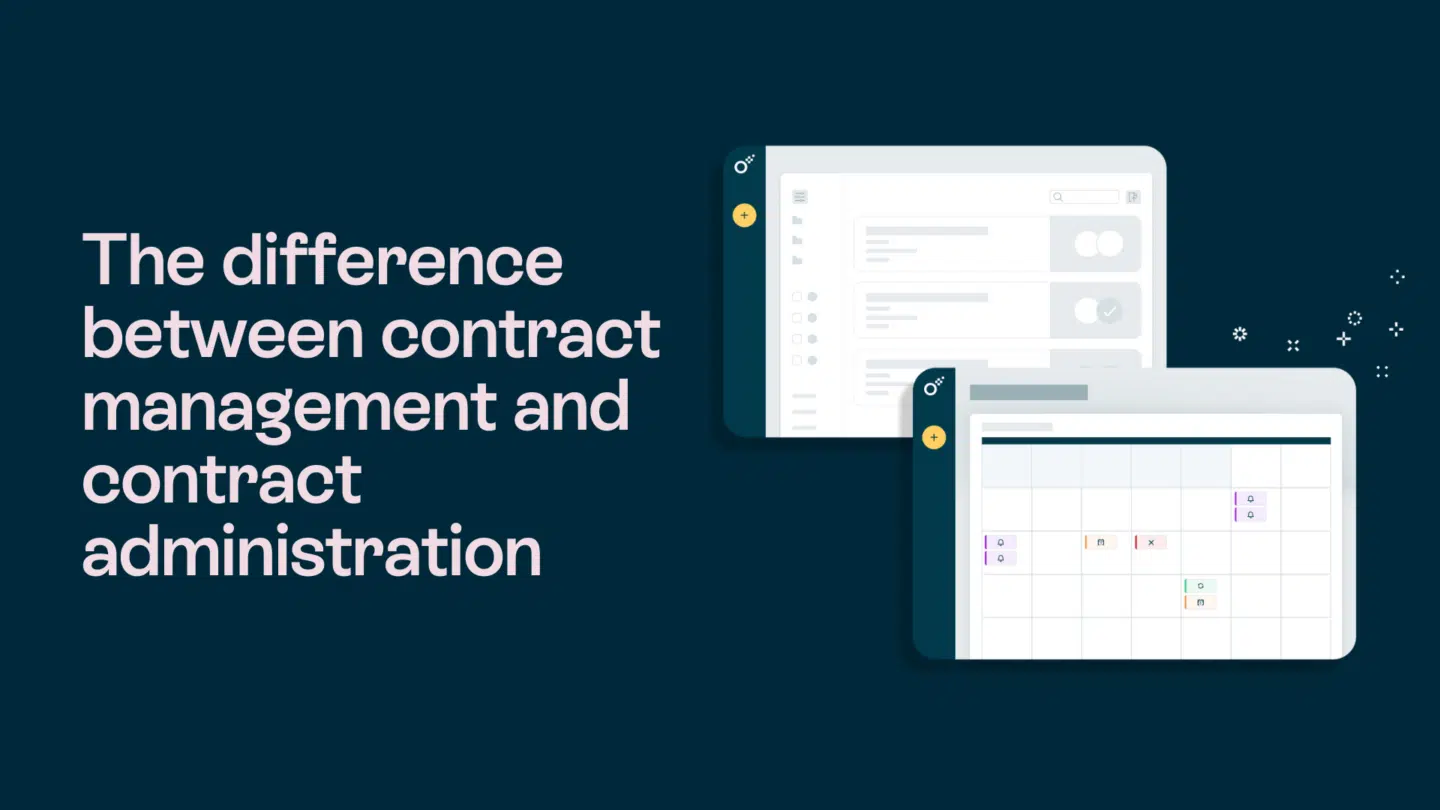How long do you think it takes to close a contract? A week? Two?
Try 24 weeks.
That’s the average for high-complexity agreements, according to the World Commerce & Contracting Benchmark Report. Even mid-tier contracts take nearly three months. That’s a whole quarter eaten up by delays, redlines and scattered emails.
Sure, PandaDoc has helped companies clean up parts of this mess, especially regarding proposals and quotes. Its intuitive user interface, content library and drag-and-drop templates make document generation fast and painless.
But here’s the catch: fast proposals aren’t the same as smart contracts. And when it comes to managing the entire contract lifecycle, from drafting and negotiation to renewal tracking, PandaDoc starts to feel inadequate.
In this PandaDoc review, we’ll walk you through PandaDoc’s core features, highlight where it shines, and where it stumbles and show you how Oneflow, a contract lifecycle management software solution, steps in as an all-in-one tool for contract lifecycle management.
Detailed PandaDoc review: 2025 edition

PandaDoc is a contract automation platform focused on proposals, quotes and contracts. Sales teams commonly use it to standardize outgoing documents and collect signatures without switching between tools.
Read also: Top 20 PandaDoc alternatives and competitors
The tool offers a structured way to create and send documents using pre-built templates and features that support high-volume document workflows. It’s suitable for teams looking to streamline proposal generation and remove repetitive formatting from the process.
But let’s face it: PandaDoc fits well into document automation workflows, not full contract lifecycle management. It focuses on helping teams put together standardized proposals and send them out for signature without manual formatting every time.
Now, let’s look at what features PandaDoc offers.
Document creation & templates
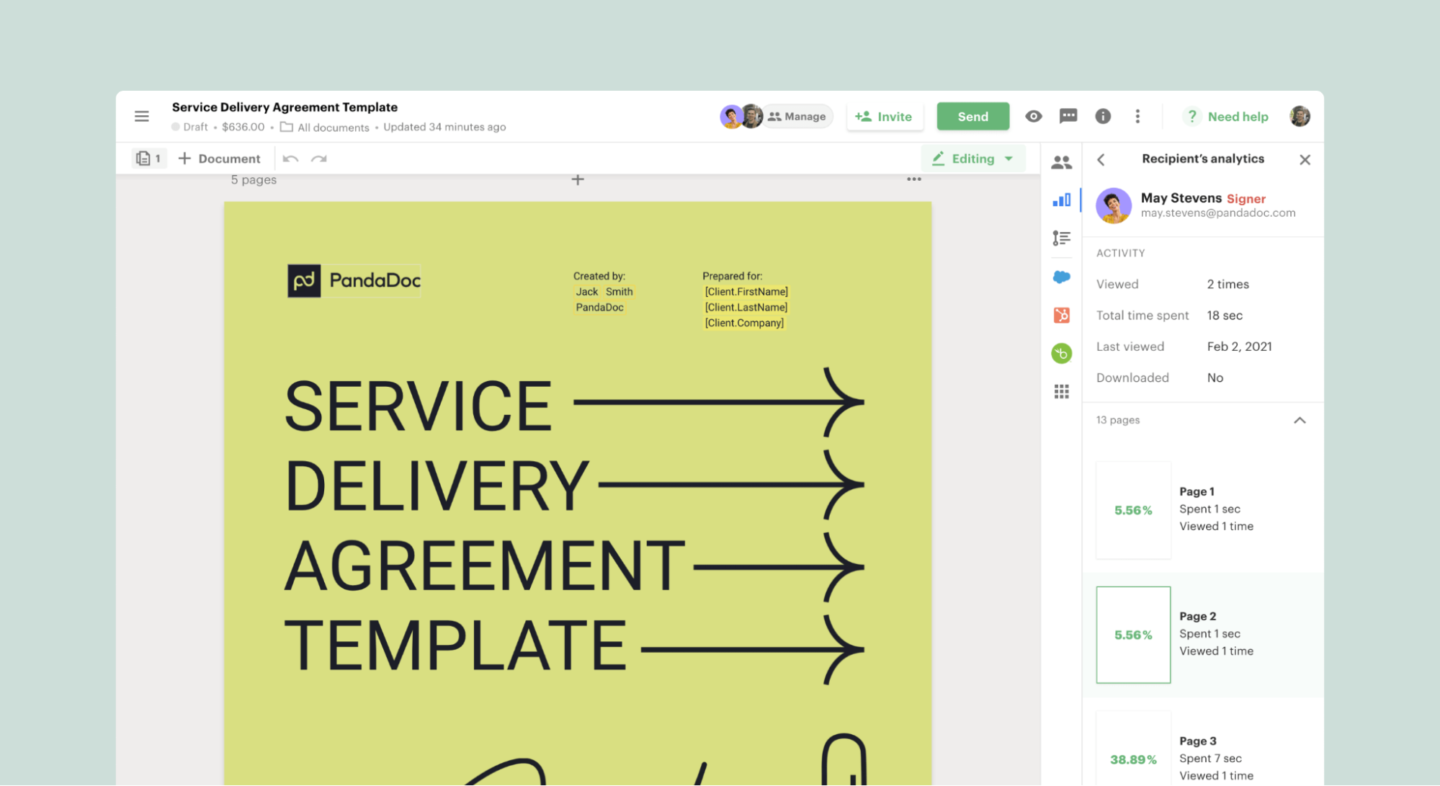
PandaDoc has tools that help users create structured documents with minimal manual formatting:
- Drag-and-drop builder: Add text, images, signature fields and other elements directly into your document.
- Templates: Use pre-designed templates for proposals, quotes and agreements. Teams can also send documents directly from pre-set templates.
- Multimedia support: Embed pricing tables, videos and images to enrich your documents.
- Content library: Save reusable blocks such as terms, disclaimers or branding elements.
- Variable fields: Auto-fill documents using CRM data or form inputs to reduce manual entry.
E-signatures
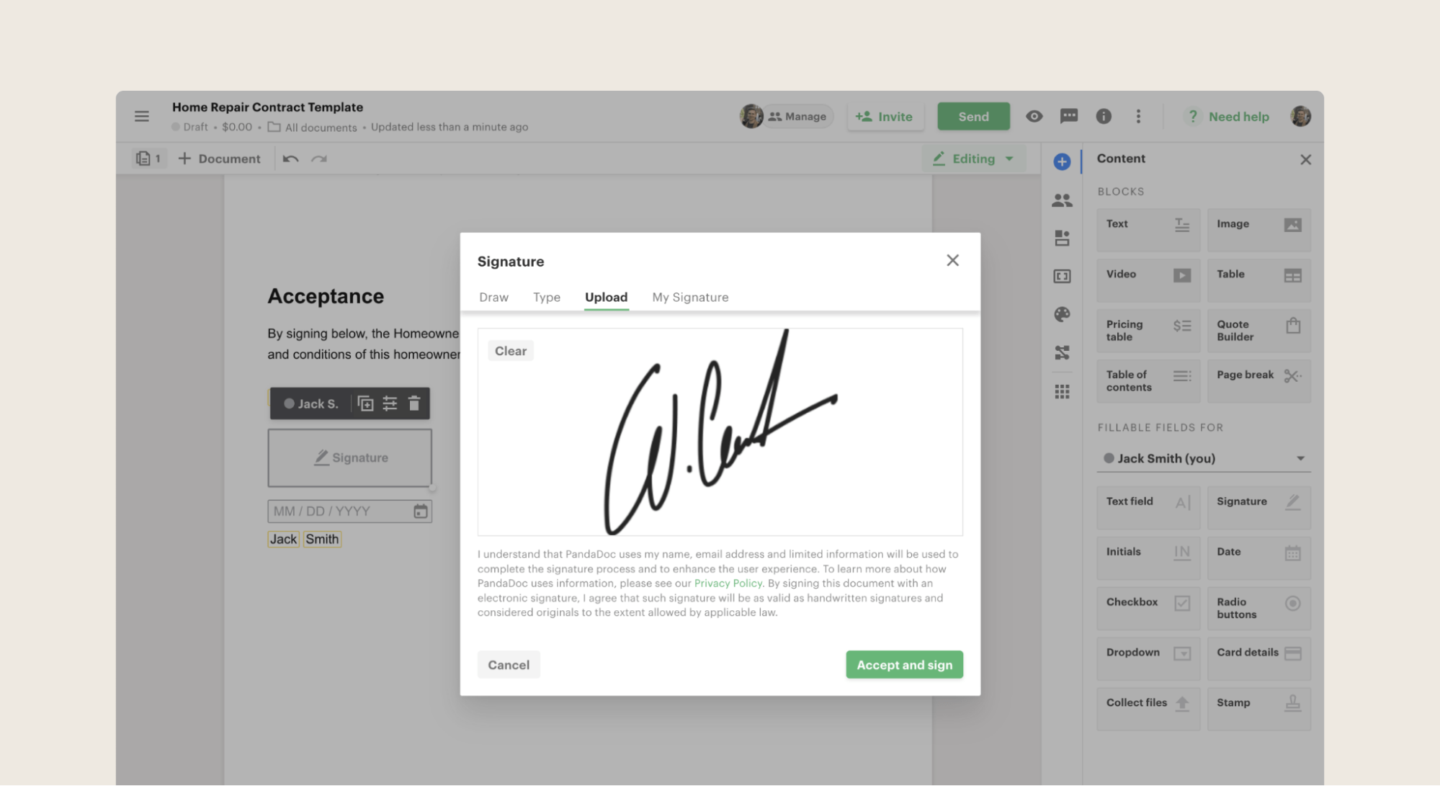
This tool collects electronic signatures in a secure and compliant way. It offers unlimited document sends for all paid plans. PandaDoc has the following features:
- Legally binding: All e-signatures comply with ESIGN and eIDAS regulations.
- Embedded signing links: Send documents via a link for direct access and completion.
- Mobile-friendly: Signers can complete documents on phones or tablets without friction.
- Certificate of completion: Automatically generated audit trail that includes signer identity and time stamps.
Read also: PandaDoc vs HelloSign: Which e-sign tool wins?
Workflow automation
PandaDoc helps users set rules, roles and reminders to keep the process moving without constant check-ins:
- Approval workflows: Set internal reviews and role-based permissions before sending.
- Automated reminders: Notify signers when a document is pending.
- Conditional logic: Show or hide fields and sections based on responses or user roles.
- Smart content blocks: These blocks automatically fill product information, pricing and contact data. They pull data from pre-set values or integrated catalogs so you can insert detailed product listings or service descriptions directly into proposals without manual entry.
PandaDoc also supports bulk send. Users can deliver multiple documents at once using templates and pre-filled data.
Integrations & CRM sync

PandaDoc connects with multiple platforms to keep data flowing and reduce the need for manual updates across systems:
- CRM integrations: Native sync with Salesforce, HubSpot, Pipedrive and Zoho lets users pull contact details, deal data and product information directly into documents.
- Payment integrations: Stripe, PayPal and similar gateways can be embedded to facilitate payment collection directly from the signed document.
- Data sync: Users can auto-populate templates with fields from integrated tools, helping teams reduce admin work and remain consistent.
Read also: PandaDoc vs Proposify: A detailed 2025 comparison
Collaboration tools
PandaDoc includes basic internal and external collaboration tools that enable participants to sign documents:
- Comments and in-document discussions: Leave feedback directly in the legal contracts to clarify changes or flag issues.
- Version history: Access previous iterations to keep track of changes over time.
- Internal approvals and negotiation tools: Get internal approval before sending the document out and use shared editing to negotiate terms with external parties.
In practice, these features help teams sign documents and collaborate with tools like in-document comments and version history. PandaDoc also offers AI-powered content suggestions, tone adjustment and smart content blocks. However, it doesn’t provide clause-level risk analysis.
Analytics & document tracking
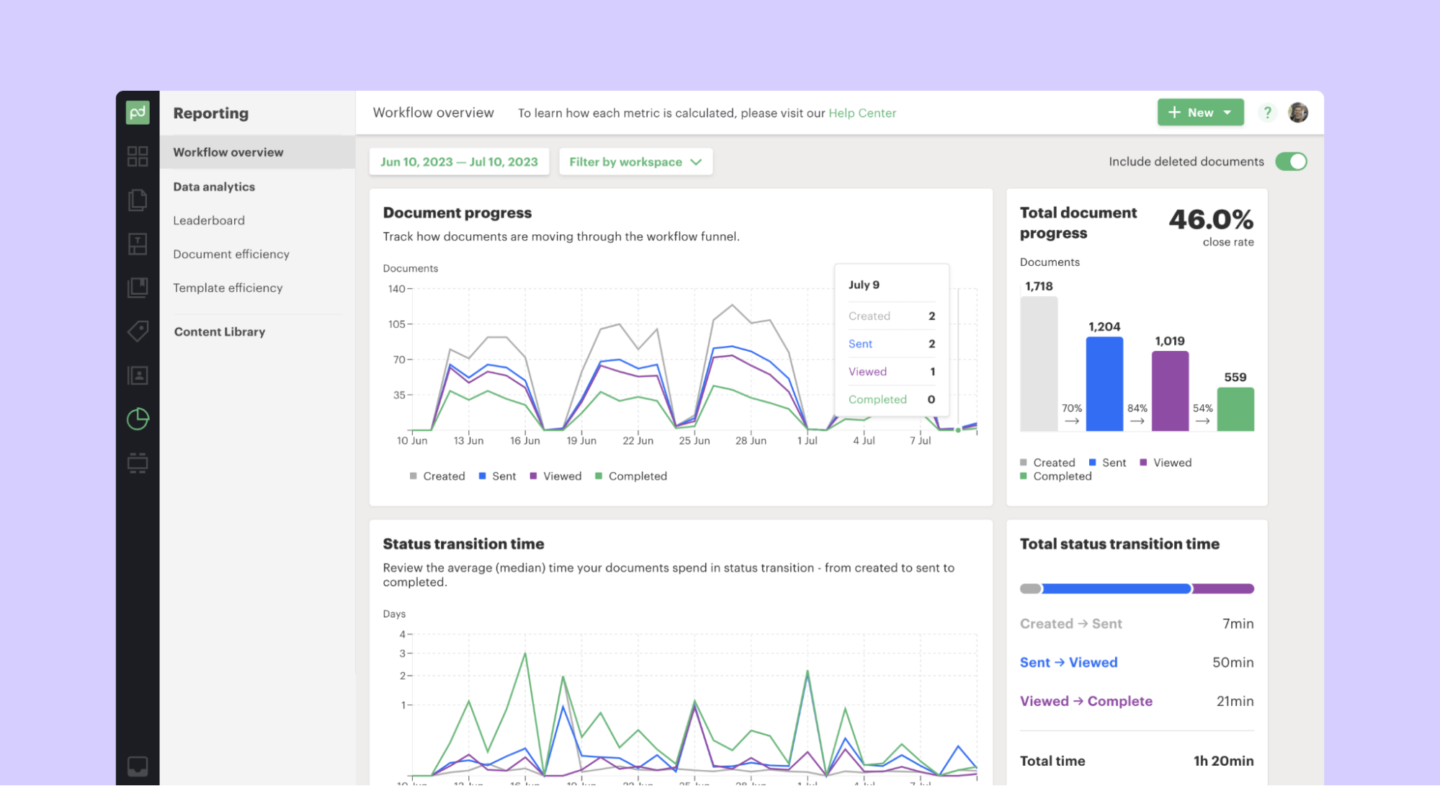
PandaDoc also includes tracking features for those who need visibility into how recipients engage with proposals and sales documents.
- Audit trail: See who opened your document, when they opened it, how long they spent on each section and what they focused on most.
- Notifications: Real-time updates when the recipient signs or comments.
- Revenue tracking: Monitor how deals progress, how long they take to close and how they stack up against expected revenue. You can also use this data to spot patterns in deal size and track which pricing strategies convert.
Read also: PandaDoc vs DocuSign: Document management duel
Where PandaDoc falls short
This PandaDoc review wouldn’t have been complete without considering the tool’s limitations. Here’s the thing, once you step outside of the sales team bubble, things get bumpy. Contract workflows for legal, procurement or HR often need flexibility, control and real-time updates—things that aren’t a strong part of PandaDoc’s offering.
- Static documents: Users create documents using an HTML-style editor, which are sent and received as static files. Any change means starting over.
- No AI insights: There is no built-in support for real-time contract review, clause suggestions or automated risk analysis.
- Limited risk analysis features: No tools for identifying risky clauses or flagging terms exist.
- Sales-first design: PandaDoc is built with sales teams in mind. However, the functionality often falls short for legal, procurement or HR use cases.
The limitations covered in this PandaDoc review show a clear gap, especially for teams beyond sales. If you’re dealing with legal workflows, procurement cycles or anything that needs more than templates and signatures, you’ll likely need something built for the entire contract journey.
That’s where Oneflow comes in.
Oneflow: A smarter contract lifecycle management solution
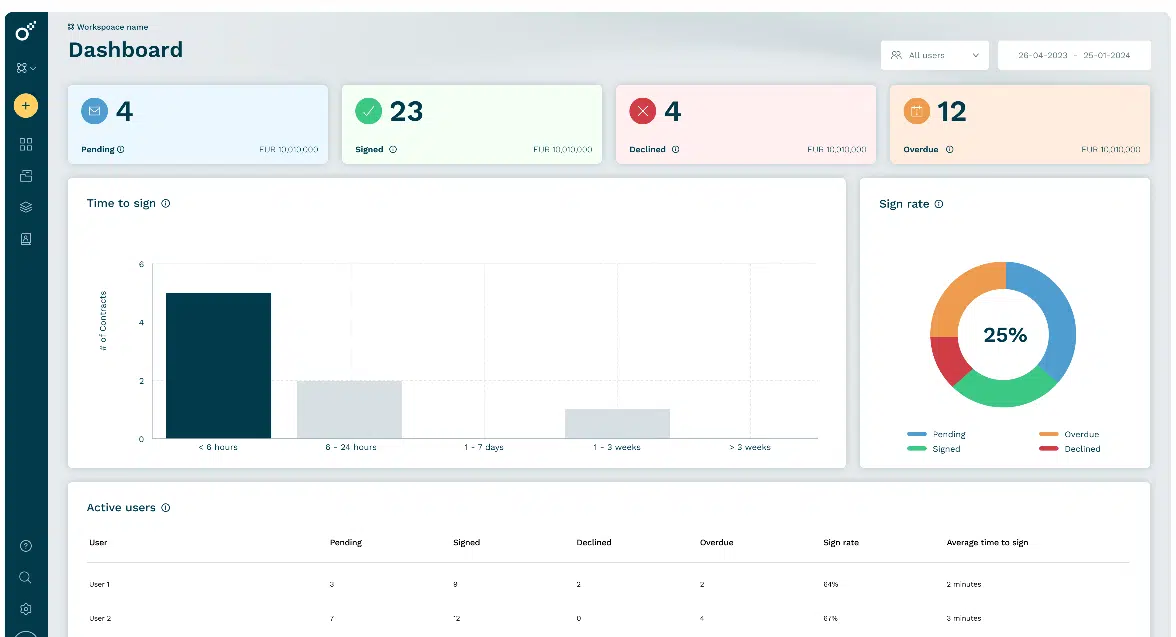
Oneflow isn’t just about getting signatures—it’s about changing how contracts work.
With Oneflow, you’re working with live, editable contracts—not static files. Here’s how it helps:
- Edit in real time: No more downloading, uploading or redlining PDFs
- Manage the full lifecycle: Version control, negotiations and approvals—all in one place
- Built-in collaboration tools:
- Approvals, tracking and AI review happen in one shared space
- Eliminates endless email threads and scattered tools
- All-in-one workflow: From first draft to renewal—no need for multiple systems
Oneflow is designed for more than just legal teams. Our contract management solution suits a wide range of industries and teams, including:
- Industries: Tech, consulting, retail, recruitment, manufacturing
- Teams: Sales, HR, procurement—anyone that needs contract visibility and momentum
Why choose Oneflow?
- Centralize and simplify your contract process
- Eliminate tool sprawl and manual steps
- Automate, manage, and optimize every stage of the workflow
Ready to work smarter with your contracts?
Try Oneflow and see how a digital contract platform can simplify your workflow from day one—or keep reading to learn more.
HTML-based contracts

Oneflow’s contracts aren’t locked once you hit send. They stay open for edits, so you can tweak terms, update numbers or adjust content during negotiation—without creating a new version each time.
You can add product tables that update pricing automatically, embed explainer videos or use conditional sections to tailor the contract depending on who’s viewing it. All of it happens in one live version, shared via a single link.
The ability to update content mid-negotiation supports complex document workflows, whether you’re adjusting pricing tables or editing terms on the fly. It’s all live, tracked and version-controlled within the same digital contract.
Real-time collaboration across teams
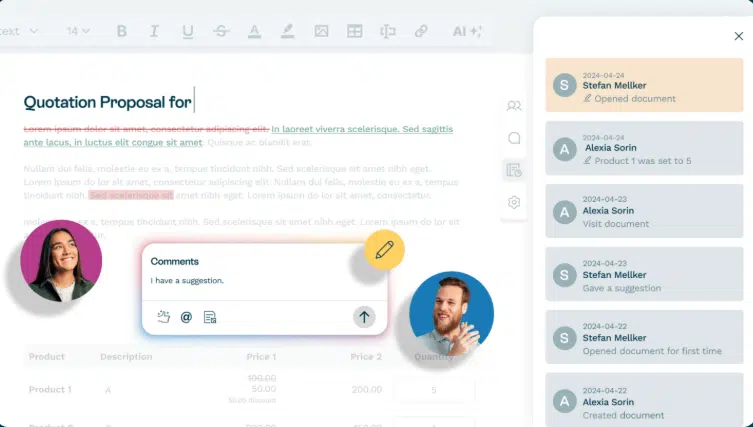
Working on contracts shouldn’t mean chasing down feedback across email threads. Oneflow keeps everything in one place, so teams can align without the mess:
- Live editing: Make edits alongside team members or customers, all in the same live document.
- In-document chat: Ask questions, suggest changes or leave notes without jumping to another tool.
- Version history: Track every change and roll back if needed.
- Internal approval workflows: Route contracts to the right people for digital signatures before they go out.
- Engagement tracking: See when someone opens the contract, what they view and how long they spend on each section.
These collaboration features make it easier for everyone involved to sign documents efficiently, without delays or missed approvals. Whether it’s HR, legal or vendors, all parties can comment, review and sign docs in one shared version of the contract.
Built-in AI for risk and compliance
Oneflow’s AI doesn’t just sit on the sidelines and wait for you to sign docs. It actively reviews your contracts and flags anything that might raise a red flag—before someone else does:
- Clause checking: Simply upload a document, and Oneflow scans it for missing or risky clauses that don’t match the usual playbook set for your business.
- Smart suggestions: Receive clause recommendations based on best practices, so you won’t have to rewrite from scratch.
- Automated risk analysis: Oneflow analyzes your contracts for potential issues so you can fix problems before they cause delays.
- Portfolio insights: The tool looks across all your contracts to track common risks, clause patterns or gaps in compliance, without digging through PDFs.
Whether you’re reviewing one agreement or an entire contract portfolio, the ability to simply upload a file and get instant feedback changes how teams manage legal risk. Oneflow helps you avoid red flags early and keep your document workflows clean and compliant—all without relying on external tools or legal back-and-forth.
Powerful signing options
Signing should be simple for the sender and secure for the recipient. Oneflow gives you multiple ways to sign—QES, BankID, SMS, handwritten signature—so you can meet different security needs without leaving the platform.
We’re talking:
- Multiple signing methods: Depending on the level of security needed, use QES, BankID, SMS or typed signature options.
- Custom signing orders: Set the signing sequence to match your approval chain. You control the flow, whether it’s legal first, then finance or all at once.
- Compliance with EU regulations: Signatures fully comply with global standards like eIDAS, and all activity is logged in your Oneflow account for audit and security.
Unified repository and calendar view
Finding the right contract shouldn’t feel like digging through a shared Google Drive. Oneflow makes it easy to stay on top of everything without the clutter, fulfilling the specific needs of every business:
- Filter, tag, and organize: Sort contracts by team, project or status. Use tags to group by department, region or use case.
- Track key dates: Support teams by making upcoming renewals and important obligations visible in one central calendar so nothing slips through the cracks.
- Role-based access: Control who can view or edit each contract based on team or workspace.
Plug-and-play integrations
Oneflow fits into the tools you already use—no extra setup, no complicated workarounds.
- CRM integrations: Connect various platforms like Salesforce, HubSpot or Microsoft Dynamics to auto-fill contracts with real-time deal data.
- HR tools: Sync with systems like Teamtailor to move contracts through hiring and onboarding without copy-pasting.
- Workspace tools: Bring in Slack, Microsoft Teams or Google Workspace to keep communication and storage in sync.
- API and Webforms: Build custom workflows, trigger contract creation automatically or gather structured data from your site or internal tools.
PandaDoc vs Oneflow: Side-by-side comparison
Here’s a side-by-side breakdown of the core features of PandaDoc and Oneflow, illustrating their different approaches to contract management.
| Feature category | PandaDoc | Oneflow |
|---|---|---|
| Primary use case | Sales proposals, quotes, e-signatures | End-to-end contract automation for all departments |
| Document format | Rich editor, PDF-based delivery | HTML-based, dynamic live contracts |
| Live collaboration | ✅ Included | ✅ Real-time editing, commenting, tracking |
| E-signature options | ✅ Basic & legal e-signatures | ✅ Advanced, incl. BankID, QES, and signing order |
| AI contract review | ❌ Not available | ✅ AI-powered insights and redlining |
| Workflow automation | ✅ For sales workflows | ✅ For full contract lifecycle (sales, HR, legal, etc.) |
| Integrations | ✅ 30+ tools + API | ✅ Salesforce, HubSpot, Dynamics, API, more |
| Repository & reminders | ✅ Basic dashboard | ✅ Calendar view, tags, team workspaces |
Final verdict: Is PandaDoc the smart choice in 2025?
PandaDoc works well if you’re sending out simple quotes or standard proposals. It’s fast, it’s familiar, and it gets the job done—for the first draft. But when your contracts need to move across departments, get reviewed by legal, updated mid-negotiation or renewed six months later, it starts to fall short.
This PandaDoc review makes one thing clear: for businesses dealing with contracts that evolve, involve multiple stakeholders or require tight collaboration, you’ll eventually hit a wall. Static files, limited AI tools and a sales-first focus make it hard to scale beyond proposals.
Oneflow fills in those gaps.
With dynamic contracts, real-time collaboration and built-in AI, Oneflow supports every stage of the contract lifecycle—not just the final signature. You can review, edit, track and sign everything in one place, with complete visibility and security from start to finish.
If you’re ready to move beyond disconnected tools and static PDFs, Oneflow is the smart choice.
Try Oneflow yourself and see what modern contract management looks like.
Disclaimer:
All information on this page is derived from publicly available sources such as G2, Capterra, and other software listing sites. Oneflow does not verify the accuracy, completeness, or currentness of this information. Accordingly, Oneflow assumes no responsibility or liability for any inaccuracies, errors, or omissions in the content, nor for any actions taken in reliance on such information. Users are advised to independently verify any information before making decisions based on it.
FAQs
Is PandaDoc trustworthy?
Yes, PandaDoc follows standard data protection protocols. That said, trust also depends on your business needs. If you need advanced security features or full control over contract workflows, its capabilities may be limited compared to platforms like Oneflow.
Is PandaDoc a Chinese company?
No, PandaDoc is not a Chinese company. It was founded in Belarus, and its headquarters are in San Francisco.
Is PandaDoc as good as Docusign?
That depends on what you’re looking for. PandaDoc is suitable for sales proposals and document generation, while Docusign is a solid choice for electronic signatures. However, if you need an all-in-one tool for contract lifecycle management, explore Oneflow.
Is PandaDoc safe and legal?
Yes, PandaDoc complies with electronic signature standards like ESIGN and UETA. That said, when dealing with sensitive contracts or industry-specific regulations, it’s always a good idea to double-check compliance requirements based on your business context.







